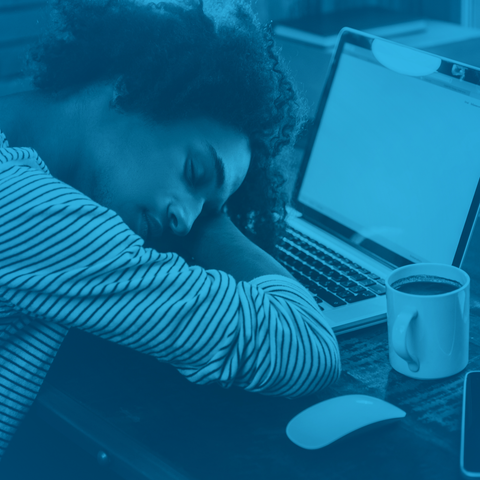
The concept of napping is a highly prevalent global phenomenon that occurs across the lifespan [1]. Research has shown that around 74% of young and middle-aged adults napped during a given week, with almost half reporting that the average nap lasted less than 20 minutes [2]. It seems then that a significant part of the population finds napping to be a useful activity to support health. Indeed, research suggests that naps can reduce sleepiness, increase energy, and improve cognitive performance [3].
The goals of this article are to explore the different types of naps, their specific benefits, and how napping influences hormones and neurotransmitters where information is available.
Power Napping
In 1998, James B. Maas coined the term “power nap” to “encourage institutionalization of naps at work” [4]. Since then, substantial work has been conducted indicating the efficacy of brief naps in the maintenance of on-the-job performance.
Although it is well documented that brief naps are more effective in the apparent reversal of sleepiness than longer ones, the scientific community has been unable to fully explain this paradox. Sleep researchers are well aware that longer naps are more likely to result in sleep inertia — a period of disorientation, confusion, and sleepiness that results after awakening from a deeper sleep stage. Sleep inertia may partially explain why longer naps are not as refreshing as shorter ones, but if short naps do not reach a deep stage of sleep, then how do they bring about their regenerative effects?
The benefits of brief naps (5-15 minutes in length) can be felt almost immediately after the nap and persist for a limited period of time (around 1-3 hours) [3]. The reversal of sleepiness following a nap of this duration seems to be driven by reductions in ascending arousal system activity, coupled with greater cerebral cortex stimulation on waking [4]. Longer naps of greater than 30 minutes can produce impairment from sleep inertia for a short while after waking but they can produce greater cognitive performance for a longer period (up to many hours) [5,6].
In people with short habitual sleep, mid-afternoon naps of between 10 and 60 minutes in duration seem to offer clear and lasting benefits for positive mood and self-reported sleepiness or alertness. While there doesn’t appear to be a “winning” duration across this range, a 30-minute nap appears to occupy the sweet spot between practicality and benefit [7].
A recent large study of UK Biobank data revealed a modest causal association between habitual daytime napping and larger total brain volume [8]. However, the contributions of specific brain regions and their influence on cognitive outcomes warrant further investigation.
Timing of Naps
In addition to the duration of a given nap, the timing of a nap in conjunction with the circadian rhythm of the body is also an important variable.
A meta-analysis (pooled study of available evidence) found early naps in the afternoon (before 1 pm) offered better cognitive performance improvements, irrespective of sex and age [9]. However, these studies were conducted under laboratory conditions and not real-world conditions, which is an important aspect to consider.
Short afternoon naps of less than 30 minutes have been shown to possess restorative effects in healthy older people, by reducing subjective sleepiness and fatigue in the afternoon, improving performance levels, and exerting beneficial effects on brain EEG activity [10].
Naps, Hormones, and Neurotransmitters
The points we discussed above concerning nap duration, timing, and physiology have implications for brain chemistry, hormones, and neurotransmitters.
Naps taken late in the day as opposed to early (in the afternoon for example) can delay the release of melatonin, a hormone released from the pineal gland that is crucial for bringing about nighttime sleep. By timing naps so that they occur earlier, the disruption of nighttime melatonin production can be avoided and thus habitual sleep preserved [11].
Research has shown that naps can help lower levels of cortisol, a hormone released in response to physical or psychological stress, thus illustrating the stress-reducing effect of naps [12,13]. This effect has also been seen concerning other stress and inflammatory markers such as salivary interleukin-6 and urinary norepinephrine [14].
It is well known that growth hormone is released during sleep, particularly in the deep sleep stages. Extended naps involving slow-wave sleep can enhance growth hormone secretion, therefore promoting the repair and rejuvenation processes in the body [15,16].
Napping can also influence insulin sensitivity. Research has revealed a U-shaped association between sleep duration and insulin sensitivity, with short and long-duration sleep associated with lower insulin sensitivity [17].
Summary
This article has discussed some of the underpinning physiology of napping and the beneficial effects it can have on performance across the lifespan.
Short power naps (10-20 minutes) seem to be beneficial for cognitive function and alertness with the least amount of disruption to the hormonal milieu, whereas longer naps of 30 minutes or more allow for deeper sleep stages to be reached. This might be beneficial for growth hormone secretion but can also result in negative effects due to sleep inertia. Napping of this kind can also impact subsequent nighttime sleep and hormonal cycles if commences too late in the day.
Irrespective of the specific duration and timing, napping can positively alter the hormonal profile, particularly about stress hormones, glucose metabolism, and growth hormone secretion.
If you need a sleep aid that’s been tried and tested, then look no further! Tro Zzz is our complete sleep solution troche that helps you go to sleep, stay asleep, and wake up feeling refreshed. Try it now!
References
[1] C.E. Milner, K.A. Cote, Benefits of napping in healthy adults: impact of nap length, time of day, age, and experience with napping, J Sleep Res 18 (2009) 272–281. https://doi.org/10.1111/j.1365-2869.2008.00718.x.
[2] J.J. Pilcher, K.R. Michalowski, R.D. Carrigan, The prevalence of daytime napping and its relationship to nighttime sleep, Behav Med 27 (2001) 71–76. https://doi.org/10.1080/08964280109595773.
[3] N. Lovato, L. Lack, The effects of napping on cognitive functioning, Prog Brain Res 185 (2010) 155–166. https://doi.org/10.1016/B978-0-444-53702-7.00009-9.
[4] P.T. George, The psycho-sensory wake drive-a power source for power naps and other common sleep-wake phenomena: a hypothesis, Sleep Breath 22 (2018) 41–48. https://doi.org/10.1007/s11325-017-1505-6.
[5] P.D. Patterson, T.S. Okerman, D.G.L. Roach, C.J. Hilditch, M.D. Weaver, C.G. Patterson, M.A. Sheffield, J.S. Di Salvatore, H. Bernstein, G. Georges, A. Andreozzi, C.M. Willson, D. Jain, S.E. Martin, L.S. Weiss, Are Short Duration Naps Better than Long Duration Naps for Mitigating Sleep Inertia? Brief Report of a Randomized Crossover Trial of Simulated Night Shift Work, Prehosp Emerg Care 27 (2023) 807–814. https://doi.org/10.1080/10903127.2023.2227696.
[6] H.M. Mulrine, T.L. Signal, M.J. van den Berg, P.H. Gander, Post-sleep inertia performance benefits of longer naps in simulated nightwork and extended operations, Chronobiol Int 29 (2012) 1249–1257. https://doi.org/10.3109/07420528.2012.719957.
[7] R.L.F. Leong, T. Lau, A.R. Dicom, T.B. Teo, J.L. Ong, M.W.L. Chee, Influence of mid-afternoon nap duration and sleep parameters on memory encoding, mood, processing speed, and vigilance, Sleep 46 (2023) zsad025. https://doi.org/10.1093/sleep/zsad025.
[8] V. Paz, H.S. Dashti, V. Garfield, Is there an association between daytime napping, cognitive function, and brain volume? A Mendelian randomization study in the UK Biobank, Sleep Health 9 (2023) 786–793. https://doi.org/10.1016/j.sleh.2023.05.002.
[9] F. Dutheil, B. Danini, R. Bagheri, M.L. Fantini, B. Pereira, F. Moustafa, M. Trousselard, V. Navel, Effects of a Short Daytime Nap on the Cognitive Performance: A Systematic Review and Meta-Analysis, Int J Environ Res Public Health 18 (2021) 10212. https://doi.org/10.3390/ijerph181910212.
[10] M. Tamaki, A. Shirota, M. Hayashi, T. Hori, Restorative effects of a short afternoon nap (<30 min) in the elderly on subjective mood, performance and eeg activity, Sleep Res Online 3 (2000) 131–139.
[11] D.-J. Dijk, S.W. Lockley, Integration of human sleep-wake regulation and circadian rhythmicity, J Appl Physiol (1985) 92 (2002) 852–862. https://doi.org/10.1152/japplphysiol.00924.2001.
[12] B. Faraut, K.Z. Boudjeltia, M. Dyzma, A. Rousseau, E. David, P. Stenuit, T. Franck, P. Van Antwerpen, M. Vanhaeverbeek, M. Kerkhofs, Benefits of napping and an extended duration of recovery sleep on alertness and immune cells after acute sleep restriction, Brain Behav Immun 25 (2011) 16–24. https://doi.org/10.1016/j.bbi.2010.08.001.
[13] A.N. Vgontzas, S. Pejovic, E. Zoumakis, H.M. Lin, E.O. Bixler, M. Basta, J. Fang, A. Sarrigiannidis, G.P. Chrousos, Daytime napping after a night of sleep loss decreases sleepiness, improves performance, and causes beneficial changes in cortisol and interleukin-6 secretion, Am J Physiol Endocrinol Metab 292 (2007) E253-261. https://doi.org/10.1152/ajpendo.00651.2005.
[14] B. Faraut, S. Nakib, C. Drogou, M. Elbaz, F. Sauvet, J.-P. De Bandt, D. Léger, Napping reverses the salivary interleukin-6 and urinary norepinephrine changes induced by sleep restriction, J Clin Endocrinol Metab 100 (2015) E416-426. https://doi.org/10.1210/jc.2014-2566.
[15] E. Van Cauter, G. Copinschi, Interrelationships between growth hormone and sleep, Growth Horm IGF Res 10 Suppl B (2000) S57-62. https://doi.org/10.1016/s1096-6374(00)80011-8.
[16] I. Karacan, A.L. Rosenbloom, J.H. Londono, R.L. Williams, P.J. Salis, Growth hormone levels during morning and afternoon naps, Behav Neuropsychiatry 6 (1974) 67–70.
[17] D. van Dijk, B. Balkau, B. Segrestin, M. Gottsäter, R. Gabriel, M. Hatunic, A. Mari, J.M. Dekker, F. Rutters, EGIR-RISC Study Group, Associations between sleep duration and sleep debt with insulin sensitivity and insulin secretion in the EGIR-RISC Study, Diabetes Metab 45 (2019) 375–381. https://doi.org/10.1016/j.diabet.2018.11.001.





Comments (0)
There are no comments for this article. Be the first one to leave a message!